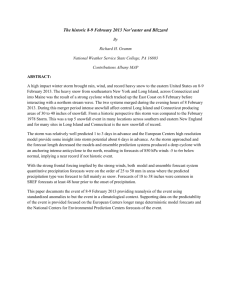Supplementary Information
advertisement
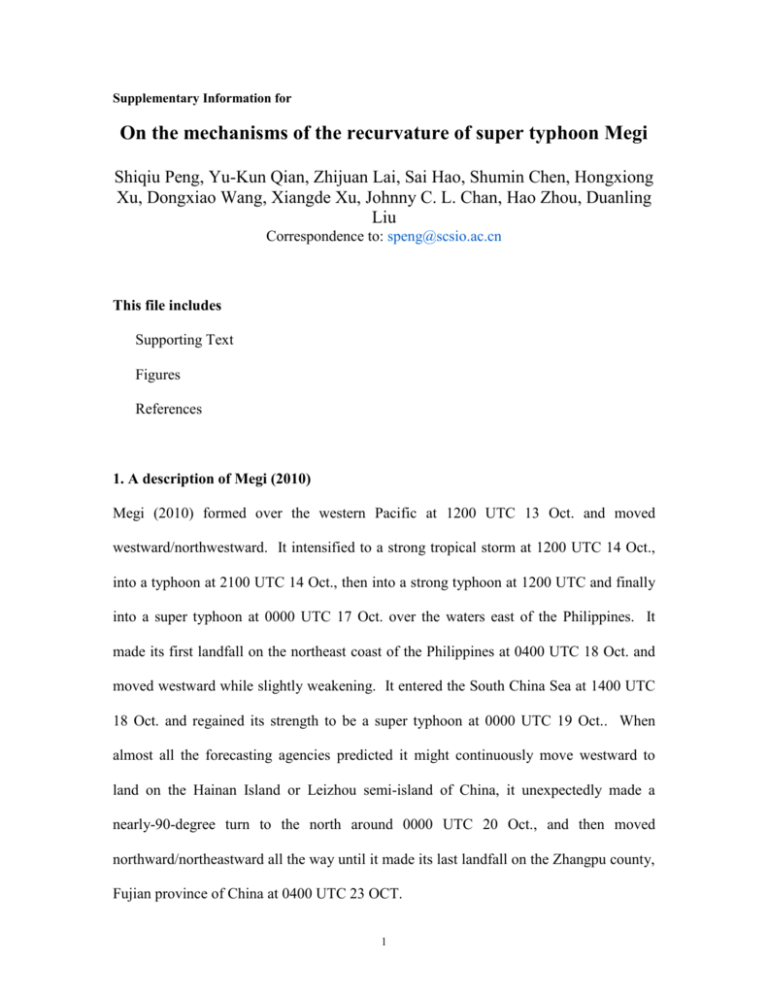
Supplementary Information for On the mechanisms of the recurvature of super typhoon Megi Shiqiu Peng, Yu-Kun Qian, Zhijuan Lai, Sai Hao, Shumin Chen, Hongxiong Xu, Dongxiao Wang, Xiangde Xu, Johnny C. L. Chan, Hao Zhou, Duanling Liu Correspondence to: speng@scsio.ac.cn This file includes Supporting Text Figures References 1. A description of Megi (2010) Megi (2010) formed over the western Pacific at 1200 UTC 13 Oct. and moved westward/northwestward. It intensified to a strong tropical storm at 1200 UTC 14 Oct., into a typhoon at 2100 UTC 14 Oct., then into a strong typhoon at 1200 UTC and finally into a super typhoon at 0000 UTC 17 Oct. over the waters east of the Philippines. It made its first landfall on the northeast coast of the Philippines at 0400 UTC 18 Oct. and moved westward while slightly weakening. It entered the South China Sea at 1400 UTC 18 Oct. and regained its strength to be a super typhoon at 0000 UTC 19 Oct.. When almost all the forecasting agencies predicted it might continuously move westward to land on the Hainan Island or Leizhou semi-island of China, it unexpectedly made a nearly-90-degree turn to the north around 0000 UTC 20 Oct., and then moved northward/northeastward all the way until it made its last landfall on the Zhangpu county, Fujian province of China at 0400 UTC 23 OCT. 1 2. A briefly introduction of EPMEF The experimental platform of marine environment forecasting (EPMEF) is a real-time air-sea-wave forecasting system for the South China Sea (SCS), which was established in the State Key Laboratory of Tropical Oceanography (LTO), South China Sea Institute of Oceanology (SCSIO) in October 2010. It consists of three main components, i.e., an atmospheric model, an ocean model and a sea wave model. The Weather Research and Forecasts (WRF) model is employed as the atmospheric model of EPMEF. WRF model was developed by the National Center for Atmospheric Research (NCAR) and the National Centers for Environmental Prediction (NCEP) in the U. S. (S1). A dynamical downscaling technique is employed for the regional atmospheric model to obtain higherresolution output with small- and meso-scale features from the lower-resolution output of a global atmospheric model. To realize this, a two-domain-nested configuration is designed, as shown in Fig. S1. The sea surface winds from the inner domain of WRF model are used to drive the ocean model and the wave model, i.e., the Princeton Ocean Model (POM) 2002 version (S2-S3) and the WAVEWATCH III (WW 3) model (S4-S5). POM is a three-dimensional ocean model with primitive equations, embedded a second moment turbulence closure model (the 2.5 Mellor-Yamada scheme; S6). The WW3 model is a third generation wave model developed at NOAA/NCEP. The governing equations of WW3 include refraction and straining of the wave field due to temporal and spatial variations of the mean water depth and the mean current (tides, surges etc.), and wave growth and decay due to the 2 actions of wind, nonlinear resonant interactions, dissipation (white capping) and bottom friction. 3. Definition of "late model" and “interpolated model" The tropical cyclone (TC) forecasts by the operational agencies of Numerical Weather Prediction (NWP) are usually based on results from a number of guidance models including multi-layer dynamical models, single-layer trajectory models, consensus models, statistical models and so on. Guidance models are characterized as either early or late, depending on whether or not they are available to the forecaster during the forecast cycle. For example, the GFS forecast made for the 1200 UTC forecast cycle would be considered a late model since it is not complete and available to the forecaster until about 1600 UTC, or about an hour after the NHC forecast is released, i.e., it could not be used to prepare the 1200 UTC official forecast. Multi-layer dynamical models are generally, if not always, late models. To make the forecast benefit from a late model as much as possible while keep it timely, a technique is adopted which adjusts the most recent available run of a late model to the current synoptic time and initial conditions. The adjustment process produces an “early” version of a late model for the current forecast cycle that is based on the most current available guidance. The adjusted version of a late model is known, mostly for historical reasons, as “interpolated model". 4. Figures 3 Figures S1, S5-S7 are plotted using NCAR Command Language (NCL) and the rest figures are all plotted by Grid Analysis and Display System (GrADS). Figure S1 | The model configuration with two nested domains. The black square indicates the inner domain. 4 Figure S2 | 900-hPa temperature (shaded, °C) and horizontal wind (vector, m s-1) at 0000 UTC 18 Oct. 2010 for different experiments. a, CTRL. b, sen_-1.5. c, sen_-1.0. d, sen_1.0. e, sen_1.5. 5 Figure S3 | Same as Figure S2 except at 0000 UTC 19 Oct. 2010. 6 Figure S4 | Same as Figure S2 except at 0000 UTC 20 Oct. 2010. 7 Figure S5 | 500-hPa geopotential height (contour with interval of 40m) and 850-hPa equivalent potential temperature anomalies relative to zonal mean (shaded, K) at the initial time (0000 UTC 18 Oct. 2010). a, CTRL. b, sen_-1.5. c, sen_-1.0. d, sen_1.0. e, sen_1.5. 8 Figure S6 | Same as Figure S5 except at 0000 UTC 20 Oct. 2010. 9 Figure S7 | Same as Figure S5 except at 0000 UTC 21 Oct. 2010. 10 11 Figure S8 | 925-hPa Temperature (shaded, K) and geopotential height (contour, m) around the recurving occurrence of the 17 TCs with a recurvature angle larger than 45° which have an apparent CAI during 1975-2012, imposed by the track of each TC. a, THELMA(1977).b, BABE(1977). c, ROSE(1978). d, FAYE(1979). e, MAC(1979). f, JOE(1983). g, THELMA(1987). h, NATHAN(1990). i, MIKE(1990). j, FAYE(1992). k, DOT(1993). l, JOEL(1994). m, HELEN(1995). n, MAGGIE(1999). o, RANANIM(2004). p, SEPAT(2007). q, MEGI(2010). Only temperature of lower than 296 k isotherm for June to September or 294 k isotherm for October (f, q) and November (i) is shaded. 12 Figure S9 | Same as Fig. S8, except at 500-hPa temperature and geopotential height. 13 Figure S10 | 925-hPa Temperature (shaded, K) and geopotential height (contour, m) around the recurving occurrence of the 4 TCs with the recurvature angle larger than 45° which have no apparent CAI during 1975-2012, imposed by the track of each TC. a, HERB (1996). b, PARMA (2009). c, CHANTHU (2010). d, VICENTE (2012). 14 Figure S11 | Same as Fig. S10, except at 500-hPa temperature and geopotential height. 15 4. References S1. Michalakes, J. G., J. Dudhia, D. Gill, J. Klemp, and W. Skamarock, 1998: Design of a next generation regional weather research and forecast model. River Edge, New Jersey: Towards Teracomputing, World Scientific, 117–124. S2. Blumberg, A.F., and G. L. Mellor, 1987: A description of a three-dimensional coastal ocean circulation model. In: Heaps, N. (Ed.), In: Three Dimensional Coastal Ocean Models, vol. 4. American Geophysical Union, Washington, DC, p. 208. S3. Mellor, G.L., 2003: Users guide for a three-dimensional, primitive equation, numerical ocean model (June 2003 version), Prog. in Atmos. and Ocean. Sci, Princeton University, p. 53. S4. Tolman, H. L., 1997: A New Global Wave Forecast System at NECP. In: Ocean Wave Measurements and Analysis, Vol. 2, (Ed: B. L. Edge and J. M. Helmsley), ASCE, 777-786. S5. Tolman, H. L., 1999: User Manual and System Documentation of WAVEWATCHIII version 1.18. Technical Note, 110 pp. S6. Mellor, G.L., and T. Yamada , 1982: Development of a turbulence closure model for geophysical fluid problems. Rev. Geophys. Space Phys., 20, 851–875. 16
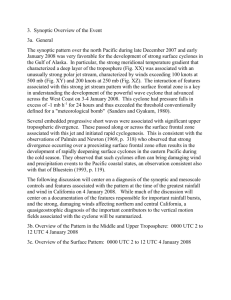

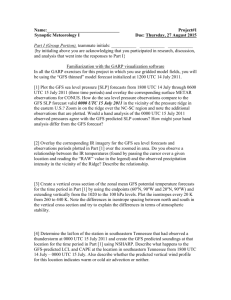






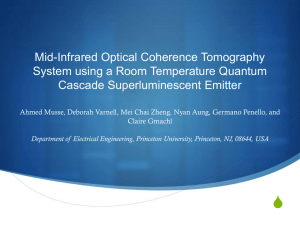
![[PowerPoint 2007] presentation file](http://s2.studylib.net/store/data/005406460_1-7834316c409f9802f7aec3d8538324fb-300x300.png)
